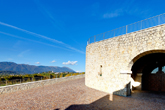
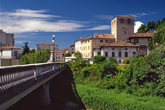
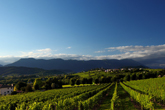
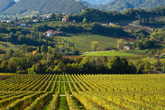
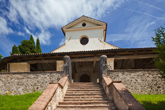
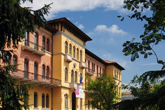
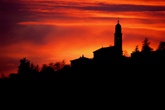
The grace
of a unique spot
It sometimes happens that a wine reflects its growing area so closely that one can catch the area’s very colours in the wine’s appearance, the scent of the air in its bouquet, and in the flavours of its palate the sapient hand that crafted it. Precisely this happens in the Bepin de Eto wines, fruit of clusters tended with the attention that comes from long experience. These hills of Conegliano and Valdobbiadene are the stewards of history-laden settlements and hamlets that vaunt the highest cultural riches, villages whose very appearance summons up an ancient viticulture that eloquently expresses the features of this land. Its history reaches back to over 2000 years ago, to when the Romans, grafting onto Etruscan beginnings, introduced the cultivation of the vine.
Centuries on, in the Late Middle Ages, Conegliano issued Statutes that regulated viticultural activities as well, and wines from the hillslopes enjoyed a growing market, as witnessed by documents in the registers of the various local Podestàs. In the 1500s, the merchants of Venice exhibited lively interest in this area’s wines, which Podestà Stefano Erizzo described as “outstanding,” particularly those from Feletto. This area was also much prized for its supply of timber, which was so vital for the construction the city’s impressive fleet. And other significant historical events must receive their due, such as the establishment, in Conegliano in 1875, of one of the country’s first advanced institutes for oenology and in 1923 of a research institute. As early as 1966 the first Italian wine road was established, the Strada del Vino Bianco, a 33-km itinerary winding among the vineyards of Conegliano and Valdobbiadene. A direct result of this was the opening in 2003 of the Strada del Prosecco e Vini dei Colli Conegliano Valdobbiadene, designed to promote the growing area, its diverse vineyard landscapes, and its wealth of historical and artistic attractions. The Wine Road passes through the commune of San Pietro di Feletto too, which makes its own distinctive natural contribution in terms of oenology and history, thanks to the 17th-century Camaldolese hermitage of Colle Capriolo, today the Town Hall, and to the church of San Pietro di Feletto, dating back to the 11th century. Farther south lie Conegliano and its Istituto Enologico G.B. Cerletti, Italy’s first winemaking school, founded 9 July 1867 by royal decree of King Victor Emmanuel II. It is an authoritative centre of research into grapevine genetics, while Professor Luigi Manzoni’s varietal crossings are still much prized today.
The Institute enjoys a prestigious reputation both in Italy and across the globe, and it continues to contribute to increasing the value of this powerful and matchless environment. Here are views that have enthused artists and poets, among them Andrea Zanzotto, who from childhood bound himself closely to this place, inspiring him to celebrate in his poems the seasons, hues, and shapes of this locus and the emotions of its people. And here, where arts and sciences have paid it tribute, just as the Ceschin family history is a living part of Bepin de Eto, so does local history further enrich its deep-rooted fascination, touching the soul and arousing emotions.
